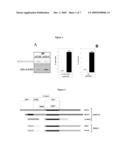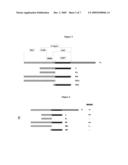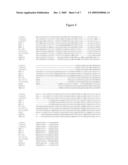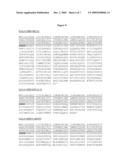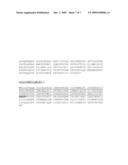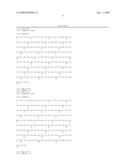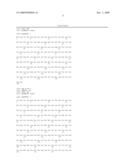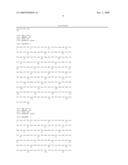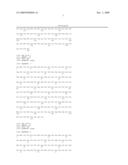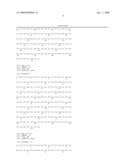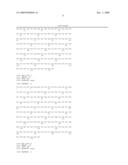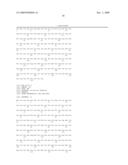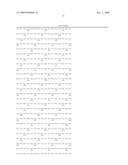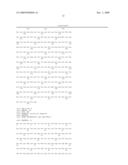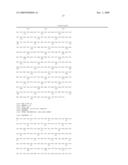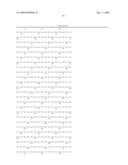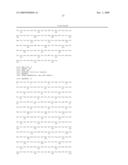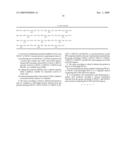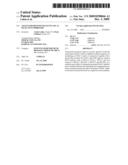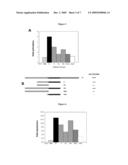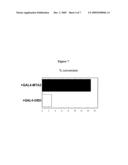Patent application title: Assays for Histone Deacetylase 1/2 Selective Inhibitors
Inventors:
Armin Lahm (Rome, IT)
Paola Gallinari (Rome, IT)
Assignees:
ISTITUTO DI RICERCHE DI BIOLOGIA MOLECOLARE P. AN
IPC8 Class: AC12Q125FI
USPC Class:
435 4
Class name: Chemistry: molecular biology and microbiology measuring or testing process involving enzymes or micro-organisms; composition or test strip therefore; processes of forming such composition or test strip
Publication date: 2009-12-03
Patent application number: 20090298046
Claims:
1. An assay for identifying a potential inhibitor of one of an HDAC1 or
HDAC 2 enzyme activity comprising the steps of:(i) incubating one of said
HDAC1 or HDAC2 enzyme with a protein that contains the SANT and ELM2
regions, found in MTA proteins such as MTA-2, MTA-1, MTA-3 and also found
in CoREST, CoREST2, CoREST3 and MI-ER1, in a suitable assay buffer;(ii)
adding the potential inhibitor and a suitable substrate under conditions
suitable for enzymatic activity to occur; and(iii) determining the effect
of the putative HDAC inhibitor on enzyme activity relative to a standard.
2. The assay according to claim 1; wherein the protein in step (i) comprises a full-length protein selected from the group consisting of MTA-1, MTA-2, MTA-3, CoREST, CoREST2, CoREST3, and MI-ER1 or a protein that has at least 80% sequence identity with one of said proteins selected from the group consisting of MTA-1, MTA-2, MTA-3, CoREST, CoREST2, CoREST3, and MI-ER1 and comprises an ELM2 and DAD regions.
3. The assay according to claim 2 wherein the protein in step (i) is full-length MTA-2.
4. A reconstituted enzymatic complex comprising HDAC1 or HDAC2 and full-length MTA-2 or a fragment thereof comprising the ELM2 and DAD regions.
5. A recombinant cell transformed with heterologous a nucleic acid molecule encoding a histone deacetylase selected from the group consisting of HDAC1 and HDAC2 and a protein comprising the ELM2 and DAD regions.
Description:
[0001]The present invention relates to a high efficiency assay, specific
for histone deacetylases 1/2 (HDAC1/2) that is suitable for the screening
of HDAC subtype-selective inhibitors.
[0002]Reversible histone acetylation has been identified as a major regulator of eukaryotic gene transcription. Lysine residues in histone tails are acetylated by histone acetyltransferases (HATs) that function as transcriptional coactivators. The acetylation of histones results in a less restrictive chromatin structure than is generally associated with transcriptional activation. Histone deacetylases (HDACs) reverse the reaction catalyzed by HATs, leading to a repressive chromatin structure. Multiple HDACs of three major classes have been identified. Class I HDACs include HDACs 1, 2, 3 and 8 and are homologous to yeast Rpd3 deacetylase, whereas class II deacetylases including HDACs 4, 5, 6, 7, and 9 are more similar to yeast Hda1. HDAC11 exhibits both similarities and distinctive features as compared with all other subtypes. A third class of HDACs includes homologs of the yeast Sir2 silencing protein which requires a NAD cofactor for activity. HDACs have been found to function in vivo as large multiprotein complexes that are targeted by DNA binding proteins to actively repress gene transcription.
[0003]HDAC3 normally exists in tight and stoichiometric complexes with corepressors N-CoR and SMRT. The enzyme activity of HDAC3 requires SMRT or N-CoR, which interact with and activate the deacetylase via a DAD domain (deacetylase activating domain), that includes one of two SANT motifs present in both corepressors. DAD comprises an N-terminal DAD-specific motif and a C-terminal SANT-like domain.
[0004]Numerous proteins involved in transcription contain a conserved SANT motif, whose function is not well understood (Boyer, L. A., Latek, R. R. and Peterson, C. L. (2004) Nat. Rev. Mol. Cell. Biol., 5: 158-163). Recombinant HDAC3 is inactive and activation occurs upon coexpression of the deacetylase and the cofactor SMRT/N-CoR in cells (like HeLa cells) or by in vitro transcription-translation of HDAC3 and SMRT/N-CoR with Rabbit Reticulocyte Lysate (RRL).
[0005]To confirm published evidence, a C-terminally flagged HDAC3 (HDAC3-FLAG) was cotransfected in cells with a construct containing the DAD region of N-CoR [(DAD was fused to the C-terminus of the DNA Binding Domain of GAL4 (GAL4-DBD)]. Additionally, HDAC3-FLAG and GAL4-DAD were individually expressed and mixed. The complexes were immunoprecipitated with anti-FLAG (for HDAC3) or anti-GAL4 (for DAD) (FIG. 1A), and incubated with a histone H4-derived octamer peptide substrate containing a single acetylated lysine. The activity is indicated as % conversion of the acetylated substrate (FIG. 1B) and confirms that SMRT/N-CoR DAD is essential for the interaction and activation of HDAC3.
[0006]HDAC1 and HDAC2 share 84% identity and it is unclear whether they have distinct functions, but they appear to play complementary roles in transcriptional repression. Known HDAC1/2 complexes contain transcriptional corepressors mSin3A (Hassig, C. A., Fleischer, T. C., Billin, A. N., Schreiber, S. L. and Ayer, D. E. (1997) Cell, 89: 341-348), CoREST (Corepressor of REST; You, A., Tong, J. K., Grozinger, C. M. and Schreiber, S. L. (2001) Proc. Natl. Acad. Sci. U.S.A., 98: 1454-1458), MTA-2 (Metastasis-associated protein 2 in NuRD complex; Zhang, Y., Ng, H.-H., Erdjument-Bromage, H., Tempst, P., Bird, A. and Reinberg, D. (1999) Genes Dev., 13: 1924-1935), MI-ER1 (Mesoderm induction early response 1; Ding, Z., Gillespie, L. L. and Paterno, G. D. (2003) Mol. Cell Biol., 23: 250-258).
[0007]A SANT motif is present in CoREST, MTA-2 and MI-ER1 (FIG. 2). We found that in all these proteins the homology is not limited to SANT, but continues at the N-terminus, permitting the definition of a DAD-homology region, as in SMRT/N-CoR (FIG. 2). HDAC1/2 corepressors have in common another domain, ELM2, first described in Eg1-27, a Caenorhabditis elegans protein that plays a fundamental role in patterning during embryonic development (Solari, F., Bateman, A. and Ahringer, J. (1999) Development, 126: 2483-2494). That part of the protein that encompasses both ELM2 and DAD, is designated the X-region in FIG. 2 (hereinafter referred to as the "X-region"). MTA-2 corepressor has an additional N-terminal domain, BAH (Bromo-adjacent homology); Goodwin, G. H. and Nicolas, R. H. (2001) Gene, 268:1-7; FIG. 3), that has been identified in a number of proteins involved in gene transcription and repression and is likely to be involved in protein-protein interactions. Based on amino acid sequence homology a number of additional proteins containing a X-region can be identified, for example MTA-1, MTA-3, CoREST, CoREST2 and CoREST3.
[0008]The SANT domain of MTA-2 seems to contribute to the binding to HDAC1 (Humphrey, G. W., Wang, Y., Russanova, V. R., Hirai, T., Qin, J., Nakatani, Y. and Howard, B. H. (2001) J. Biol. Chem., 276: 6817-6824), and in CoREST looks essential for HDAC1 functional interaction (You, A., Tong, J. K., Grozinger, C. M. and Schreiber, S. L. (2001) Proc. Natl. Acad. Sci. U.S.A., 98: 1454-1458). On the other hand, in MI-ER1 Ding et al. mapped the domain responsible for recruiting HDAC1 activity and mediating transcriptional repression to a region containing ELM2; their analysis shows that the SANT domain of MI-ER1 is dispensable for productive interaction with HDAC1.
[0009]A number of MTA-2 deletion mutants were constructed and fused to GAL4-DBD C-terminus (FIG. 3 and experimental). After coexpression with flagged-HDAC1 and co-immune purification with anti-FLAG, the association of the MTA2 mutants with HDAC1 was measured (FIG. 4).
[0010]As shown in FIG. 4, neither the DAD-homology region nor the ELM2 domain were sufficient for the binding of the corepressor to HDAC1. The complete X-region, comprising both domains, was necessary and sufficient for the interaction in these experiments, whereas BAH appeared to be dispensable.
[0011]The same coimmunopurified complexes were incubated with the H4-derived acetylated peptide substrate. All samples were normalised to contain HDAC1-FLAG at the same low, sub-optimal concentration (0.25 nM) (FIG. 5A). At this concentration, HDAC1 was not active in the absence of the recombinant corepressors: to observe enzymatic activity, it was necessary to use at least 5 nM of HDAC1-FLAG (not shown).
[0012]The data clearly show that the full-length corepressor MTA-2 gave the best activation of HDAC1: a 5-fold-activation with respect to the background level (DBD) was measured as an average of three independent experiments (FIG. 5A). The activation capacity of the constructs is summarized in FIG. 5B.
[0013]Confirmatory results were obtained in a transcriptional repression assay, in which GAL4-MTA2 expression vectors were cotransfected into cells together with a GAL4-dependent reporter construct (FIG. 6).
[0014]The repression was HDAC-dependent, since in the presence of an HDAC inhibitor transcription was restored (data not shown).
From these experiments, it can be concluded that: [0015]Removal of the SANT domain from MTA-2 based chimeras decreases the binding, the activation potential and the transcription repressive function; [0016]The ELM2 domain is essential, but is not sufficient for HDAC1 function; [0017]The minimal activation domain for HDAC1 is the X-region, that encompasses both ELM2 and DAD-homology region; [0018]Maximal activation of HDAC1 is obtained with the full length MTA-2 corepressor.
[0019]Similar results were obtained repeating (some of) the experiments with HDAC2 and with another corepressor, CoREST.
[0020]The ability of the MTA-2 corepressor, or fragments of it containing the X-region, to enhance HDAC1 and/or 2 catalytic activities represents a novel finding. In particular, by co-purifying HDAC1 and 2 with the complete MTA-2 corepressor, it was possible to enhance the catalytic efficiency of the deacetylase in the order of one log (FIG. 7 and not shown). To observe enzymatic activity with HDAC1/2, it is necessary to use at least 5 nM of the deacetylase, whereas in the presence of the corepressor a concentration of 0.25 nM is sufficient). This finding, which has not previously been reported, enables the establishment of a high efficiency assay specific for histone deacetylase 1 and 2 that is suitable for screening of HDAC subtype-selective inhibitors since sub-nanomolar enzyme concentrations are sufficient to obtain suitable substrate conversions.
[0021]Histone deacetylases are known to play key roles in the regulation of cell proliferation, consequently inhibition of HDACs has become an interesting approach for anti-cancer therapy. To this purpose, it is very important to devise subtype-selective enzymatic assays with small amounts of enzymes.
[0022]FIG. 9 shows GAL DBD, underlined, and the GSGS linker which is in bold.
[0023]Accordingly, in a first aspect the present invention provides an assay specific for histone deacetylases HDAC1 and/or 2 inhibitors which comprises: [0024](i) incubating an HDAC1 and/or 2 enzyme(s) together with a protein that contains the SANT and ELM2 regions, found in MTA proteins such as MTA-2, MTA-1, MTA-3 and also found in CoREST, CoREST2, CoREST3 and MI-ER1, in a suitable assay buffer [0025](ii) adding the potential HDAC inhibitor and a suitable substrate and incubating [0026](iii) stopping the incubation and determining the effect the putative HDAC inhibitor has had on enzyme activity by comparison with standards.
[0027]Suitably the protein in step (i) is a recombinant protein that is preferably expressed in mammalian cells. The protein suitably contains full-length MTA-1, MTA-2, MTA-3, CoREST, CoREST2, CoREST3, MI-ER1 or a protein that has substantial sequence identity with one of these proteins (and suitably at least 80% and preferably at least 85% sequence identity) and contains the X-region (as herein described) or a fragment of one of these proteins containing the X-region (as herein described). Preferably, the protein is full-length MTA-2.
[0028]In a further embodiment, the protein in step (i) is a recombinant protein that is preferably expressed in mammalian cells. The protein suitably contains an X-region that has substantial sequence identity with the X-region of an MTA protein, such as MTA-2, MTA-1 or MTA-3, or the X-region of CoREST, CoREST2, CoREST3 or MI-ER1 (and suitably at least 80% and preferably at least 85% sequence identity).
[0029]The present invention further relates to a reconstituted enzymatic complex containing HDAC1 or HDAC2 and a protein that consists essentially of full-length MTA-2 or a fragment of this that contains its X region.
[0030]Recombinant cells that have been transformed with heterologous DNA to express HDAC1 and/or HDAC2 and at least the amino acids of the X region are also provided by the present invention.
[0031]In particular aspects of performing the method, aliquots of the enzyme, and in particular the recombinant enzyme, are provided together with the protein containing the SANT and ELM2 motifs. Each aliquot is deposited in the well of a microplate. Serial dilutions of a test analyte being tested for HDAC inhibitor activity are made and each dilution is added to a separate well of the microtitre plate containing the cells. Optionally, the method can include serial dilutions of a known HDAC inhibitor as a positive control and further can include negative controls. Each aliquot is deposited in the well of a microplate. A plurality of test analytes being tested for HDAC inhibitor activity are each added to a separate well of the microtiter plate containing the enzyme together with the protein containing the SANT and ELM2 motifs. In further aspects, serial dilutions of the plurality of analytes are made and each dilution is added to a separate well of the microtiter plate containing the cells.
[0032]The following examples serve to illustrate the present invention and the manner in which it can be performed.
EXAMPLES
Flagged-HDAC1/2 Co-Expression With GAL4-MTA2/CoREST in HeLa Cells: Transient Transfection, Preparation of Soluble Extracts, and Affinity Purification
[0033]The mammalian expression vectors used for transient co-transfection into HeLa cells were the following: pCDNA HDAC1-FLAG or pCMV HDAC2-FLAG together with pCDNA GAL4 DBD-MTA2/CoREST, or the corresponding deletion mutants.
[0034]107 HeLa cells were transfected with 7.5 micrograms of pCDNA-HDAC1-FLAG or pCMV-HDAC2-FLAG together with 7.5 micrograms of pCDNA-GAL4DBD-MTA2/CoREST plasmid DNAs using Lipofectamine reagent (Invitrogen) according to the manufacturer recommendations.
[0035]Cells were collected in 1×PBS 24 hr after transfection, centrifuged at 1500×g for 5 min at 4° C., and washed twice with 1×PBS. After centrifugation, cell pellets were stored frozen at -80° C. Cell lysates were obtained by resuspending the cell pellet in 1 ml of hypotonic lysis buffer (20 mM Hepes pH 7.9, 0.25 mM EDTA, 10% glycerol, 1 mM PMSF, Complete EDTA-free protease inhibitors cocktail from Boehringer), followed by incubation 15' on ice, cell disruption in a 2 ml Douncer (B, 25 strokes), and addition to the homogenate of 150 mM KCl and 0.5% NP40 (isotonic lysis buffer: ILB). Soluble whole cell extracts were obtained by sonicating samples for 30 sec twice (output 5/6, duty cycle 90, timer constant), followed by a 1-hr incubation on a rotating wheel at 4° C. Upon centrifugation at 12000 rpm in SS34 rotor for 30 min at 4° C., the clear supernatant (soluble protein extract) was collected, and the total protein concentration determined using the BioRad reagent. Flagged-HDAC concentration in the extract was estimated by running 4, 8, and 16 micrograms of total protein on a 4-12% SDS-PAGE minigel together with 8-16 ng of reference protein, followed by Western blot analysis with an anti-FLAG alkaline phosphatase-conjugated monoclonal antibody (M2-AP, A9469, SIGMA). The expression levels of GAL4 DBD-MTA2/CoREST chimeric protein in the same extract was assessed on the same immunoblot developed with an anti-GAL4 rabbit polyclonal antibody (Santa Cruz Biotechnology, sc-577).
[0036]Soluble protein extracts containing flagged HDAC1 or HDAC2 in combination with each of the GAL4 DBD-MTA2 or CoREST variants were applied on anti-FLAG M2 Affinity gel (A2220, SIGMA) prepared according to the manufacturer recommendations and equilibrated in ILB. Gel matrix and soluble protein extract were mixed (10 microliters of gel matrix for each 2 micrograms of flagged-HDAC), and incubated O.N. on a rotating wheel at 4° C. The gel matrix was recovered by centrifugation, and washed once with ILB, twice with ILB containing 0.1% NP-40, and 2 more times in elution buffer [50 mM Hepes pH 7.4, 5% glycerol, 0.01% Triton X-100, 100 mM KCl. HDAC complexes were eluted by adding to the gel matrix 10 volumes of elution buffer containing 100 micrograms/ml of 3×FLAG peptide (F4799, SIGMA), followed by a 1 hr-incubation on a rotating wheel at RT. Upon centrifugation, eluted proteins were collected in the supernatant and flagged-HDAC1/2 concentration estimated by anti-FLAG Western blot analysis using 10, 20, and 30 ng of reference protein for quantification. The presence of each of the HDAC-associated GAL4 DBD-MTA2/CoREST variants was assessed on the same immunoblot developed with anti-GAL4 antibody.
Flagged-HDAC1/2 and GAL4-MTA2/CoREST Expression by Coupled in vitro Transcription-Translation and Affinity Purification
[0037]The TNT Quick Coupled Transcription/Translation System (Promega) was used following the manufacturer recommendations. For mixing experiments, 4 micrograms of each of the expression plasmid DNAs were used to drive the synthesis in vitro of the corresponding protein (flagged-HDAC or GAL4 DBD-MTA2/CoREST) in a reaction volume of 120 microlitres. For coexpression experiments, 0.8 micrograms of flagged-HDAC1/2 expression plasmid DNA and 6 micrograms of each cofactor expression plasmid DNA were added to the same reaction in a volume of 200 microlitres. After completion of the protein synthesis step, for mixing experiments, 25 microlitres of the HDAC1/2 TNT reaction were mixed with 100 microlitres of the cofactor TNT reaction and the final volume was brought to 200 microlitres by adding 75 microlitres of a mock TNT reaction. Samples were then incubated at room temperature for 10-15 minutes. 200 microlitres of HDAC1/2 +cofactor mixtures were applied on 30 microlitres anti-FLAG M2 Affinity gel prepared according to the manufacturer recommendations and equilibrated in M2-IP buffer (20 mM Hepes pH 7.9, 300 mM KCl, 0.25 mM EDTA, 10% glycerol, 0.1% Tween 20, COMPLETE EDTA-free protease inhibitors cocktail). After an incubation O.N. on a rotating wheel at 4° C., the gel matrix was recovered by centrifugation, and washed once with M2-IP buffer, twice with M2-IP buffer containing 150 mM KCl, and 2 more times in HDAC HPLC activity buffer (50 mM Hepes pH 7.4, 5% Glycerol, 0.01% Triton X100, 0.1 mg/ml BSA). One fifth of the sample was analyzed by SDS-PAGE and Western blot. The remaining gel matrix was recovered by centrifugation and incubated in a final volume of 100 microliters of HDAC activity buffer for HPLC deacetylase assays.
HDAC HPLC Activity Assay
[0038]2 microliters of the test compound solution in 100 % DMSO (50×) were added to 100 microliters of assay buffer (50 mM Hepes pH 7.4, 5% Glycerol, 0.01% Triton X100, 0.1 mg/ml BSA) containing a fixed concentration of recombinant enzyme. After pre-incubation at room temperature for 15 min, 2 microliters of a 200 μM pre-dilution in DMSO of the fluorescent histone H4 (AcK 16) peptide substrate (final concentration: 4 μM) were added [peptide substrate: Mca-GAK(ε-Ac)RHRKV-NH2 λex 325 nM; λem 393 nM]. The deacetylase reaction was performed at room temperature for 4 hours and stopped by addition of 20 μl of 10% Trifluoro Acetic Acid (TFA) aqueous solution. The percentage of peptide substrate converted to the corresponding deacetylated product was analyzed by HPLC with a Merck-Hitachi chromatograph on a Beckman (4.6 mm×5 cm) C18 column eluted at 1 ml/min with a 24 ml linear gradient from 5% to 40% acetonitrile in H2O, followed by a steep gradient (1 ml) up to 95% acetonitrile and an additional 3ml-step at 95% acetonitrile.
[0039]Most exogenously expressed recombinant HDACs were found to be inactive or scarcely active. On the contrary, recombinant enzymes expressed in mammalian cells have the same propensity as their endogenous counterparts to interact with specific regulatory polypeptides that affect their activity. The main hurdle to using mammalian cells for large-scale HDAC production resides however in the relatively low protein yields. To observe enzymatic activity with HDAC1/2, it is necessary to use at least 5 nM of the deacetylase. We found that HDAC1/2 activity is enhanced in the order of one log in the presence of the corepressor MTA-2. This allows scaling-up of the assay throughput, since sub-nanomolar enzyme concentrations (0.25 nM) are sufficient to obtain suitable substrate conversions.
Amino Acid Sequence Alignment of Proteins Containing the X-Region
[0040]Additional proteins containing the X region were identified by searching protein sequence databases using the amino acid sequence of the X-region from MTA-2. CoREST or MI-ER1 as query. The results are shown in FIG. 8.
Sequence CWU
1
161148PRThuman 1Met Arg Val Gly Pro Gln Tyr Gln Ala Val Val Pro Asp Phe
Asp Pro1 5 10 15Ala Lys
Leu Ala Arg Arg Ser Gln Glu Arg Asp Asn Leu Gly Met Leu 20
25 30Val Trp Ser Pro Asn Gln Asn Leu Ser
Glu Ala Lys Leu Asp Glu Tyr 35 40
45Ile Ala Ile Ala Lys Glu Lys His Gly Tyr Asn Met Glu Gln Ala Leu 50
55 60Gly Met Leu Phe Trp His Lys His Asn
Ile Glu Lys Ser Leu Ala Asp65 70 75
80Leu Pro Asn Phe Thr Pro Phe Pro Asp Glu Trp Thr Val Glu
Asp Lys 85 90 95Val Leu
Phe Glu Gln Ala Phe Ser Phe His Gly Lys Thr Phe His Arg 100
105 110Ile Gln Gln Met Leu Pro Asp Lys Ser
Ile Ala Ser Leu Val Lys Phe 115 120
125Tyr Tyr Ser Trp Lys Lys Thr Arg Thr Lys Thr Ser Val Met Asp Arg
130 135 140His Ala Arg Lys1452147PRThuman
2Ile Arg Val Gly Thr Asn Tyr Gln Ala Val Ile Pro Glu Cys Lys Pro1
5 10 15Glu Ser Pro Ala Arg Tyr
Ser Asn Lys Glu Leu Lys Gly Met Leu Val 20 25
30Trp Ser Pro Asn His Cys Val Ser Asp Ala Lys Leu Asp
Lys Tyr Ile 35 40 45Ala Met Ala
Lys Glu Lys His Gly Tyr Asn Ile Glu Gln Ala Leu Gly 50
55 60Met Leu Leu Trp His Lys His Asp Val Glu Lys Ser
Leu Ala Asp Leu65 70 75
80Ala Asn Phe Thr Pro Phe Pro Asp Glu Trp Thr Val Glu Asp Lys Val
85 90 95Leu Phe Glu Gln Ala Phe
Gly Phe His Gly Lys Cys Phe Gln Arg Ile 100
105 110Gln Gln Met Leu Pro Asp Lys Leu Ile Pro Ser Leu
Val Lys Tyr Tyr 115 120 125Tyr Ser
Trp Lys Lys Thr Arg Ser Arg Thr Ser Val Met Asp Arg Gln 130
135 140Ala Arg Arg1453146PRThuman 3Met Arg Val Gly
Ala Glu Tyr Gln Ala Arg Ile Pro Glu Phe Asp Pro1 5
10 15Gly Ala Thr Lys Tyr Thr Asp Lys Asp Asn
Gly Gly Met Leu Val Trp 20 25
30Ser Pro Tyr His Ser Ile Pro Asp Ala Lys Leu Asp Glu Tyr Ile Ala
35 40 45Ile Ala Lys Glu Lys His Gly Tyr
Asn Val Glu Gln Ala Leu Gly Met 50 55
60Leu Phe Trp His Lys His Asn Ile Glu Lys Ser Leu Ala Asp Leu Pro65
70 75 80Asn Phe Thr Pro Phe
Pro Asp Glu Trp Thr Val Glu Asp Lys Val Leu 85
90 95Phe Glu Gln Ala Phe Ser Phe His Gly Lys Ser
Phe His Arg Ile Gln 100 105
110Gln Met Leu Pro Asp Lys Thr Ile Ala Ser Leu Val Lys Tyr Tyr Tyr
115 120 125Ser Trp Lys Lys Thr Arg Ser
Arg Thr Ser Leu Met Asp Arg Gln Ala 130 135
140Arg Lys1454180PRThuman 4Ile Arg Val Gly Asn Arg Tyr Gln Ala Asp
Ile Thr Asp Leu Leu Lys1 5 10
15Glu Gly Glu Glu Asp Gly Arg Asp Gln Ser Arg Leu Glu Thr Gln Val
20 25 30Trp Glu Ala His Asn Pro
Leu Thr Asp Lys Gln Ile Asp Gln Phe Leu 35 40
45Val Val Ala Arg Ser Val Gly Thr Phe Ala Arg Ala Leu Asp
Cys Ser 50 55 60Ser Ser Val Arg Gln
Pro Ser Leu His Met Ser Ala Ala Ala Ala Ser65 70
75 80Arg Asp Ile Thr Leu Phe His Ala Met Asp
Thr Leu His Lys Asn Ile 85 90
95Tyr Asp Ile Ser Lys Ala Ile Ser Ala Leu Val Pro Gln Gly Gly Pro
100 105 110Val Leu Cys Arg Asp
Glu Met Glu Glu Trp Ser Ala Ser Glu Ala Asn 115
120 125Leu Phe Glu Glu Ala Leu Glu Lys Tyr Gly Lys Asp
Phe Thr Asp Ile 130 135 140Gln Gln Asp
Phe Leu Pro Trp Lys Ser Leu Thr Ser Ile Ile Glu Tyr145
150 155 160Tyr Tyr Met Trp Lys Thr Thr
Asp Arg Tyr Val Gln Gln Lys Arg Leu165 170
175Lys Ala Ala Glu1805180PRThuman 5Ile Arg Val Gly Cys Lys Tyr Gln Ala
Glu Ile Pro Asp Arg Leu Val1 5 10
15Glu Gly Glu Ser Asp Asn Arg Asn Gln Gln Lys Met Glu Met Lys
Val 20 25 30Trp Asp Pro Asp
Asn Pro Leu Thr Asp Arg Gln Ile Asp Gln Phe Leu 35
40 45Val Val Ala Arg Ala Val Gly Thr Phe Ala Arg Ala
Leu Asp Cys Ser 50 55 60Ser Ser Ile
Arg Gln Pro Ser Leu His Met Ser Ala Ala Ala Ala Ser65 70
75 80Arg Asp Ile Thr Leu Phe His Ala
Met Asp Thr Leu Gln Arg Asn Gly 85 90
95Tyr Asp Leu Ala Lys Ala Met Ser Thr Leu Val Pro Gln Gly
Gly Pro 100 105 110Val Leu Cys
Arg Asp Glu Met Glu Glu Trp Ser Ala Ser Glu Ala Met 115
120 125Leu Phe Glu Glu Ala Leu Glu Lys Tyr Gly Lys
Asp Phe Asn Asp Ile 130 135 140Arg Gln
Asp Phe Leu Pro Trp Lys Ser Leu Ala Ser Ile Val Gln Phe145
150 155 160Tyr Tyr Met Trp Lys Thr Thr
Asp Arg Tyr Ile Gln Gln Lys Arg Leu 165
170 175Lys Ala Ala Glu 1806180PRThuman 6Ile
Arg Val Gly Pro Arg Tyr Gln Ala Asp Ile Pro Glu Met Leu Leu1
5 10 15Glu Gly Glu Ser Asp Glu Arg
Glu Gln Ser Lys Leu Glu Val Lys Val 20 25
30Trp Asp Pro Asn Ser Pro Leu Thr Asp Arg Gln Ile Asp Gln
Phe Leu 35 40 45Val Val Ala Arg
Ala Val Gly Thr Phe Ala Arg Ala Leu Asp Cys Ser 50 55
60Ser Ser Val Arg Gln Pro Ser Leu His Met Ser Ala Ala
Ala Ala Ser65 70 75
80Arg Asp Ile Thr Leu Phe His Ala Met Asp Thr Leu Tyr Arg His Ser
85 90 95Tyr Asp Leu Ser Ser Ala
Ile Ser Val Leu Val Pro Leu Gly Gly Pro 100
105 110Val Leu Cys Arg Asp Glu Met Glu Glu Trp Ser Ala
Ser Glu Ala Ser 115 120 125Leu Phe
Glu Glu Ala Leu Glu Lys Tyr Gly Lys Asp Phe Asn Asp Ile 130
135 140Arg Gln Asp Phe Leu Pro Trp Lys Ser Leu Thr
Ser Ile Ile Glu Tyr145 150 155
160Tyr Tyr Met Trp Lys Thr Thr Asp Arg Tyr Val Gln Gln Lys Arg Leu
165 170 175Lys Ala Ala Glu
1807168PRThuman 7Ile Met Val Gly Ser Met Phe Gln Ala Glu Ile Pro
Val Gly Ile Cys1 5 10
15Arg Tyr Lys Glu Asn Glu Lys Val Tyr Glu Asn Asp Asp Gln Leu Leu
20 25 30Trp Asp Pro Glu Tyr Leu Pro
Glu Asp Lys Val Ile Ile Phe Leu Lys 35 40
45Asp Ala Ser Arg Arg Thr Gly Asp Glu Lys Gly Val Glu Ala Ile
Pro 50 55 60Glu Gly Ser His Ile Lys
Asp Asn Glu Gln Ala Leu Tyr Glu Leu Val65 70
75 80Lys Cys Asn Phe Asp Thr Glu Glu Ala Leu Arg
Arg Leu Arg Phe Asn 85 90
95Val Lys Ala Ala Arg Glu Glu Leu Ser Val Trp Thr Glu Glu Glu Cys
100 105 110Arg Asn Phe Glu Gln Gly
Leu Lys Ala Tyr Gly Lys Asp Phe His Leu 115 120
125Ile Gln Ala Asn Lys Val Arg Thr Arg Ser Val Gly Glu Cys
Val Ala 130 135 140Phe Tyr Tyr Met Trp
Lys Lys Ser Glu Arg Tyr Asp Phe Phe Ala Gln145 150
155 160Gln Thr Arg Phe Gly Lys Lys Lys
1658167PRThuman 8Ile Met Val Gly Pro Gln Phe Gln Ala Asp Leu Ser Asn
Leu His Leu1 5 10 15Asn
Arg His Cys Glu Lys Ile Tyr Glu Asn Glu Asp Gln Leu Leu Trp 20
25 30Asp Pro Ser Val Leu Pro Glu Arg
Glu Val Glu Glu Phe Leu Tyr Arg 35 40
45Ala Val Lys Arg Arg Trp His Glu Met Ala Gly Pro Gln Leu Pro Glu
50 55 60Gly Glu Ala Val Lys Asp Ser Glu
Gln Ala Leu Tyr Glu Leu Val Lys65 70 75
80Cys Asn Phe Asn Val Glu Glu Ala Leu Arg Arg Leu Arg
Phe Asn Val 85 90 95Lys
Val Ile Arg Asp Gly Leu Cys Ala Trp Ser Glu Glu Glu Cys Arg
100 105 110Asn Phe Glu His Gly Phe Arg
Val His Gly Lys Asn Phe His Leu Ile 115 120
125Gln Ala Asn Lys Val Arg Thr Arg Ser Val Gly Glu Cys Val Glu
Tyr 130 135 140Tyr Tyr Leu Trp Lys Lys
Ser Glu Arg Tyr Asp Tyr Phe Ala Gln Gln145 150
155 160Thr Arg Leu Gly Arg Arg Lys
1659167PRThuman 9Ile Met Ile Gly Leu Gln Tyr Gln Ala Glu Ile Pro Pro Tyr
Leu Gly1 5 10 15Glu Tyr
Asp Gly Asn Glu Lys Val Tyr Glu Asn Glu Asp Gln Leu Leu 20
25 30Trp Cys Pro Asp Val Val Leu Glu Ser
Lys Val Lys Glu Tyr Leu Val 35 40
45Glu Thr Ser Leu Arg Thr Gly Ser Glu Lys Ile Met Asp Arg Ile Ser 50
55 60Ala Gly Thr His Thr Arg Asp Asn Glu
Gln Ala Leu Tyr Glu Leu Leu65 70 75
80Lys Cys Asn His Asn Ile Lys Glu Ala Ile Glu Arg Tyr Cys
Cys Asn 85 90 95Gly Lys
Ala Ser Gln Gly Met Thr Ala Trp Thr Glu Glu Glu Cys Arg 100
105 110Ser Phe Glu His Ala Leu Met Leu Phe
Gly Lys Asp Phe His Leu Ile 115 120
125Gln Lys Asn Lys Val Arg Thr Arg Thr Val Ala Glu Cys Val Ala Phe
130 135 140Tyr Tyr Met Trp Lys Lys Ser
Glu Arg Tyr Asp Tyr Phe Ala Gln Gln145 150
155 160Thr Arg Phe Gly Lys Lys Arg
16510171PRThuman 10Ile Arg Val Gly Pro Ser His Gln Ala Lys Leu Pro Asp
Leu Gln Pro1 5 10 15Phe
Pro Ser Pro Asp Gly Asp Thr Val Thr Gln His Glu Glu Leu Val 20
25 30Trp Met Pro Gly Val Asn Asp Cys
Asp Leu Leu Met Tyr Leu Arg Ala 35 40
45Ala Arg Ser Met Ala Ala Phe Ala Gly Met Cys Asp Gly Gly Ser Thr
50 55 60Glu Asp Gly Cys Val Ala Ala Ser
Arg Asp Asp Thr Thr Leu Asn Ala65 70 75
80Leu Asn Thr Leu His Glu Ser Gly Tyr Asp Ala Gly Lys
Ala Leu Gln 85 90 95Arg
Leu Val Lys Lys Pro Val Pro Lys Leu Ile Glu Lys Cys Trp Thr
100 105 110Glu Asp Glu Val Lys Arg Phe
Val Lys Gly Leu Arg Gln Tyr Gly Lys 115 120
125Asn Phe Phe Arg Ile Arg Lys Glu Leu Leu Pro Asn Lys Glu Thr
Gly 130 135 140Glu Leu Ile Thr Phe Tyr
Tyr Tyr Trp Lys Lys Thr Pro Glu Ala Ala145 150
155 160Ser Ser Arg Ala His Arg Arg His Arg Arg Gln
165 17011167PRThuman 11Ile Asn Ile Gly Leu
Arg Phe Gln Ala Glu Ile Pro Glu Leu Gln Asp1 5
10 15Ile Ser Ala Leu Ala Gln Asp Thr His Lys Ala
Thr Leu Val Trp Lys 20 25
30Pro Trp Pro Glu Leu Glu Asn His Asp Leu Gln Gln Arg Val Glu Asn
35 40 45Leu Leu Asn Leu Cys Cys Ser Ser
Ala Leu Pro Gly Gly Gly Thr Asn 50 55
60Ser Glu Phe Ala Leu His Ser Leu Phe Glu Ala Lys Gly Asp Val Met65
70 75 80Val Ala Leu Glu Met
Leu Leu Leu Arg Lys Pro Val Arg Leu Lys Cys 85
90 95His Pro Leu Ala Asn Tyr His Tyr Ala Gly Ser
Asp Lys Trp Thr Ser 100 105
110Leu Glu Arg Lys Leu Phe Asn Lys Ala Leu Ala Thr Tyr Ser Lys Asp
115 120 125Phe Ile Phe Val Gln Lys Met
Val Lys Ser Lys Thr Val Ala Gln Cys 130 135
140Val Glu Tyr Tyr Tyr Thr Trp Lys Lys Ile Met Arg Leu Gly Arg
Lys145 150 155 160His Arg
Thr Arg Leu Ala Glu 16512168PRThuman 12Ile Asn Ile Gly Ser
Arg Phe Gln Ala Glu Ile Pro Glu Leu Gln Glu1 5
10 15Arg Ser Leu Ala Gly Thr Asp Glu His Val Ala
Ser Leu Val Trp Lys 20 25
30Pro Trp Gly Asp Met Met Ile Ser Ser Glu Thr Gln Asp Arg Val Thr
35 40 45Glu Leu Cys Asn Val Ala Cys Ser
Ser Val Met Pro Gly Gly Gly Thr 50 55
60Asn Leu Glu Leu Ala Leu His Cys Leu His Glu Ala Gln Gly Asn Val65
70 75 80Gln Val Ala Leu Glu
Thr Leu Leu Leu Arg Gly Pro His Lys Pro Arg 85
90 95Thr His Leu Leu Ala Asp Tyr Arg Tyr Thr Gly
Ser Asp Val Trp Thr 100 105
110Pro Ile Glu Lys Arg Leu Phe Lys Lys Ala Phe Tyr Ala His Lys Lys
115 120 125Asp Phe Tyr Leu Ile His Lys
Met Ile Gln Thr Lys Thr Val Ala Gln 130 135
140Cys Val Glu Tyr Tyr Tyr Ile Trp Lys Lys Met Ile Lys Phe Asp
Cys145 150 155 160Gly Arg
Ala Pro Gly Leu Glu Lys 16513822PRTArtificial SequenceGAL4
DBD-MTA2 13Met Lys Leu Leu Ser Ser Ile Glu Gln Ala Cys Asp Ile Cys Arg
Leu1 5 10 15Lys Lys Leu
Lys Cys Ser Lys Glu Lys Pro Lys Cys Ala Lys Cys Leu 20
25 30Lys Asn Asn Trp Glu Cys Arg Tyr Ser Pro
Lys Thr Lys Arg Ser Pro 35 40
45Leu Thr Arg Ala His Leu Thr Glu Val Glu Ser Arg Leu Glu Arg Leu 50
55 60Glu Gln Leu Phe Leu Leu Ile Phe Pro
Arg Glu Asp Leu Asp Met Ile65 70 75
80Leu Lys Met Asp Ser Leu Gln Asp Ile Lys Ala Leu Leu Thr
Gly Leu 85 90 95Phe Val
Gln Asp Asn Val Asn Lys Asp Ala Val Thr Asp Arg Leu Ala 100
105 110Ser Val Glu Thr Asp Met Pro Leu Thr
Leu Arg Gln His Arg Ile Ser 115 120
125Ala Thr Ser Ser Ser Glu Glu Ser Ser Asn Lys Gly Gln Arg Gln Leu
130 135 140Thr Val Ser Pro Glu Phe Gly
Ser Gly Ser Met Ala Ala Asn Met Tyr145 150
155 160Arg Val Gly Asp Tyr Val Tyr Phe Glu Asn Ser Ser
Ser Asn Pro Tyr 165 170
175Leu Val Arg Arg Ile Glu Glu Leu Asn Lys Thr Ala Asn Gly Asn Val
180 185 190Glu Ala Lys Val Val Cys
Leu Phe Arg Arg Arg Asp Ile Ser Ser Ser 195 200
205Leu Asn Ser Leu Ala Asp Ser Asn Ala Arg Glu Phe Glu Glu
Glu Ser 210 215 220Lys Gln Pro Gly Val
Ser Glu Gln Gln Arg His Gln Leu Lys His Arg225 230
235 240Glu Leu Phe Leu Ser Arg Gln Phe Glu Ser
Leu Pro Ala Thr His Ile 245 250
255Arg Gly Lys Cys Ser Val Thr Leu Leu Asn Glu Thr Asp Ile Leu Ser
260 265 270Gln Tyr Leu Glu Lys
Glu Asp Cys Phe Phe Tyr Ser Leu Val Phe Asp 275
280 285Pro Val Gln Lys Thr Leu Leu Ala Asp Gln Gly Glu
Ile Arg Val Gly 290 295 300Cys Lys Tyr
Gln Ala Glu Ile Pro Asp Arg Leu Val Glu Gly Glu Ser305
310 315 320Asp Asn Arg Asn Gln Gln Lys
Met Glu Met Lys Val Trp Asp Pro Asp 325
330 335Asn Pro Leu Thr Asp Arg Gln Ile Asp Gln Phe Leu
Val Val Ala Arg 340 345 350Ala
Val Gly Thr Phe Ala Arg Ala Leu Asp Cys Ser Ser Ser Ile Arg 355
360 365Gln Pro Ser Leu His Met Ser Ala Ala
Ala Ala Ser Arg Asp Ile Thr 370 375
380Leu Phe His Ala Met Asp Thr Leu Gln Arg Asn Gly Tyr Asp Leu Ala385
390 395 400Lys Ala Met Ser
Thr Leu Val Pro Gln Gly Gly Pro Val Leu Cys Arg 405
410 415Asp Glu Met Glu Glu Trp Ser Ala Ser Glu
Ala Met Leu Phe Glu Glu 420 425
430Ala Leu Glu Lys Tyr Gly Lys Asp Phe Asn Asp Ile Arg Gln Asp Phe
435 440 445Leu Pro Trp Lys Ser Leu Ala
Ser Ile Val Gln Phe Tyr Tyr Met Trp 450 455
460Lys Thr Thr Asp Arg Tyr Ile Gln Gln Lys Arg Leu Lys Ala Ala
Glu465 470 475 480Ala Asp
Ser Lys Leu Lys Gln Val Tyr Ile Pro Thr Tyr Thr Lys Pro
485 490 495Asn Pro Asn Gln Ile Ile Ser
Val Gly Ser Lys Pro Gly Met Asn Gly 500 505
510Ala Gly Phe Gln Lys Gly Leu Thr Cys Glu Ser Cys His Thr
Thr Gln 515 520 525Ser Ala Gln Trp
Tyr Ala Trp Gly Pro Pro Asn Met Gln Cys Arg Leu 530
535 540Cys Ala Ser Cys Trp Ile Tyr Trp Lys Lys Tyr Gly
Gly Leu Lys Thr545 550 555
560Pro Thr Gln Leu Glu Gly Ala Thr Arg Gly Thr Thr Glu Pro His Ser
565 570 575Arg Gly His Leu Ser
Arg Pro Glu Ala Gln Ser Leu Ser Pro Tyr Thr 580
585 590Thr Ser Ala Asn Arg Ala Lys Leu Leu Ala Lys Asn
Arg Gln Thr Phe 595 600 605Leu Leu
Gln Thr Thr Lys Leu Thr Arg Leu Ala Arg Arg Met Cys Arg 610
615 620Asp Leu Leu Gln Pro Arg Arg Ala Ala Arg Arg
Pro Tyr Ala Pro Ile625 630 635
640Asn Ala Asn Ala Ile Lys Ala Glu Cys Ser Ile Arg Leu Pro Lys Ala
645 650 655Ala Lys Thr Pro
Leu Lys Ile His Pro Leu Val Arg Leu Pro Leu Ala 660
665 670Thr Ile Val Lys Asp Leu Val Ala Gln Ala Pro
Leu Lys Pro Lys Thr 675 680 685Pro
Arg Gly Thr Lys Thr Pro Ile Asn Arg Asn Gln Leu Ser Gln Asn 690
695 700Arg Gly Leu Gly Gly Ile Met Val Lys Arg
Ala Tyr Glu Thr Met Ala705 710 715
720Gly Ala Gly Val Pro Phe Ser Ala Asn Gly Arg Pro Leu Ala Ser
Gly 725 730 735Ile Arg Ser
Ser Ser Gln Pro Ala Ala Lys Arg Gln Lys Leu Asn Pro 740
745 750Ala Asp Ala Pro Asn Pro Val Val Phe Val
Ala Thr Lys Asp Thr Arg 755 760
765Ala Leu Arg Lys Ala Leu Thr His Leu Glu Met Arg Arg Ala Ala Arg 770
775 780Arg Pro Asn Leu Pro Leu Lys Val
Lys Pro Thr Leu Ile Ala Val Arg785 790
795 800Pro Pro Val Pro Leu Pro Ala Pro Ser His Pro Ala
Ser Thr Asn Glu 805 810
815Pro Ile Val Leu Glu Asp 82014334PRTArtificial SequenceGAL4
DBD-MTA2-X 14Met Lys Leu Leu Ser Ser Ile Glu Gln Ala Cys Asp Ile Cys Arg
Leu1 5 10 15Lys Lys Leu
Lys Cys Ser Lys Glu Lys Pro Lys Cys Ala Lys Cys Leu 20
25 30Lys Asn Asn Trp Glu Cys Arg Tyr Ser Pro
Lys Thr Lys Arg Ser Pro 35 40
45Leu Thr Arg Ala His Leu Thr Glu Val Glu Ser Arg Leu Glu Arg Leu 50
55 60Glu Gln Leu Phe Leu Leu Ile Phe Pro
Arg Glu Asp Leu Asp Met Ile65 70 75
80Leu Lys Met Asp Ser Leu Gln Asp Ile Lys Ala Leu Leu Thr
Gly Leu 85 90 95Phe Val
Gln Asp Asn Val Asn Lys Asp Ala Val Thr Asp Arg Leu Ala 100
105 110Ser Val Glu Thr Asp Met Pro Leu Thr
Leu Arg Gln His Arg Ile Ser 115 120
125Ala Thr Ser Ser Ser Glu Glu Ser Ser Asn Lys Gly Gln Arg Gln Leu
130 135 140Thr Val Ser Pro Glu Phe Gly
Ser Gly Ser Ile Arg Val Gly Cys Lys145 150
155 160Tyr Gln Ala Glu Ile Pro Asp Arg Leu Val Glu Gly
Glu Ser Asp Asn 165 170
175Arg Asn Gln Gln Lys Met Glu Met Lys Val Trp Asp Pro Asp Asn Pro
180 185 190Leu Thr Asp Arg Gln Ile
Asp Gln Phe Leu Val Val Ala Arg Ala Val 195 200
205Gly Thr Phe Ala Arg Ala Leu Asp Cys Ser Ser Ser Ile Arg
Gln Pro 210 215 220Ser Leu His Met Ser
Ala Ala Ala Ala Ser Arg Asp Ile Thr Leu Phe225 230
235 240His Ala Met Asp Thr Leu Gln Arg Asn Gly
Tyr Asp Leu Ala Lys Ala 245 250
255Met Ser Thr Leu Val Pro Gln Gly Gly Pro Val Leu Cys Arg Asp Glu
260 265 270Met Glu Glu Trp Ser
Ala Ser Glu Ala Met Leu Phe Glu Glu Ala Leu 275
280 285Glu Lys Tyr Gly Lys Asp Phe Asn Asp Ile Arg Gln
Asp Phe Leu Pro 290 295 300Trp Lys Ser
Leu Ala Ser Ile Val Gln Phe Tyr Tyr Met Trp Lys Thr305
310 315 320Thr Asp Arg Tyr Ile Gln Gln
Lys Arg Leu Lys Ala Ala Glu 325
33015636PRTArtificial SequenceGAL4 DBD-CoREST 15Met Lys Leu Leu Ser Ser
Ile Glu Gln Ala Cys Asp Ile Cys Arg Leu1 5
10 15Lys Lys Leu Lys Cys Ser Lys Glu Lys Pro Lys Cys
Ala Lys Cys Leu 20 25 30Lys
Asn Asn Trp Glu Cys Arg Tyr Ser Pro Lys Thr Lys Arg Ser Pro 35
40 45Leu Thr Arg Ala His Leu Thr Glu Val
Glu Ser Arg Leu Glu Arg Leu 50 55
60Glu Gln Leu Phe Leu Leu Ile Phe Pro Arg Glu Asp Leu Asp Met Ile65
70 75 80Leu Lys Met Asp Ser
Leu Gln Asp Ile Lys Ala Leu Leu Thr Gly Leu 85
90 95Phe Val Gln Asp Asn Val Asn Lys Asp Ala Val
Thr Asp Arg Leu Ala 100 105
110Ser Val Glu Thr Asp Met Pro Leu Thr Leu Arg Gln His Arg Ile Ser
115 120 125Ala Thr Ser Ser Ser Glu Glu
Ser Ser Asn Lys Gly Gln Arg Gln Leu 130 135
140Thr Val Ser Pro Glu Phe Gly Ser Gly Ser Met Val Glu Lys Gly
Pro145 150 155 160Glu Val
Ser Gly Lys Arg Arg Gly Arg Asn Asn Ala Ala Ala Ser Ala
165 170 175Ser Ala Ala Ala Ala Ser Ala
Ala Ala Ser Ala Ala Cys Ala Ser Pro 180 185
190Ala Ala Thr Ala Ala Ser Gly Ala Ala Ala Ser Ser Ala Ser
Ala Ala 195 200 205Ala Ala Ser Ala
Ala Ala Ala Pro Asn Asn Gly Gln Asn Lys Ser Leu 210
215 220Ala Ala Ala Ala Pro Asn Gly Asn Ser Ser Ser Asn
Ser Trp Glu Glu225 230 235
240Gly Ser Ser Gly Ser Ser Ser Asp Glu Glu His Gly Gly Gly Gly Met
245 250 255Arg Val Gly Pro Gln
Tyr Gln Ala Val Val Pro Asp Phe Asp Pro Ala 260
265 270Lys Leu Ala Arg Arg Ser Gln Glu Arg Asp Asn Leu
Gly Met Leu Val 275 280 285Trp Ser
Pro Asn Gln Asn Leu Ser Glu Ala Lys Leu Asp Glu Tyr Ile 290
295 300Ala Ile Ala Lys Glu Lys His Gly Tyr Asn Met
Glu Gln Ala Leu Gly305 310 315
320Met Leu Phe Trp His Lys His Asn Ile Glu Lys Ser Leu Ala Asp Leu
325 330 335Pro Asn Phe Thr
Pro Phe Pro Asp Glu Trp Thr Val Glu Asp Lys Val 340
345 350Leu Phe Glu Gln Ala Phe Ser Phe His Gly Lys
Thr Phe His Arg Ile 355 360 365Gln
Gln Met Leu Pro Asp Lys Ser Ile Ala Ser Leu Val Lys Phe Tyr 370
375 380Tyr Ser Trp Lys Lys Thr Arg Thr Lys Thr
Ser Val Met Asp Arg His385 390 395
400Ala Arg Lys Gln Lys Arg Glu Arg Glu Glu Ser Glu Asp Glu Leu
Glu 405 410 415Glu Ala Asn
Gly Asn Asn Pro Ile Asp Ile Glu Val Asp Gln Asn Lys 420
425 430Glu Ser Lys Lys Glu Val Pro Pro Thr Glu
Thr Val Pro Gln Val Lys 435 440
445Lys Glu Lys His Ser Thr Gln Ala Lys Asn Arg Ala Lys Arg Lys Pro 450
455 460Pro Lys Gly Met Phe Leu Ser Gln
Glu Asp Val Glu Ala Val Ser Ala465 470
475 480Asn Ala Thr Ala Ala Thr Thr Val Leu Arg Gln Leu
Asp Met Glu Leu 485 490
495Val Ser Val Lys Arg Gln Ile Gln Asn Ile Lys Gln Thr Asn Ser Ala
500 505 510Leu Lys Glu Lys Leu Asp
Gly Gly Ile Glu Pro Tyr Arg Leu Pro Glu 515 520
525Val Ile Gln Lys Cys Asn Ala Arg Trp Thr Thr Glu Glu Gln
Leu Leu 530 535 540Ala Val Gln Ala Ile
Arg Lys Tyr Gly Arg Asp Phe Gln Ala Ile Ser545 550
555 560Asp Val Ile Gly Asn Lys Ser Val Val Gln
Val Lys Asn Phe Phe Val 565 570
575Asn Tyr Arg Arg Arg Phe Asn Ile Asp Glu Val Leu Gln Glu Trp Glu
580 585 590Ala Glu His Gly Lys
Glu Glu Thr Asn Gly Pro Ser Asn Gln Lys Pro 595
600 605Val Lys Ser Pro Asp Asn Ser Ile Lys Met Pro Glu
Glu Glu Asp Glu 610 615 620Ala Pro Val
Leu Asp Val Arg Tyr Ala Ser Ala Ser625 630
63516302PRTArtificial SequenceGAL4 DBD-CoREST-X 16Met Lys Leu Leu Ser
Ser Ile Glu Gln Ala Cys Asp Ile Cys Arg Leu1 5
10 15Lys Lys Leu Lys Cys Ser Lys Glu Lys Pro Lys
Cys Ala Lys Cys Leu 20 25
30Lys Asn Asn Trp Glu Cys Arg Tyr Ser Pro Lys Thr Lys Arg Ser Pro
35 40 45Leu Thr Arg Ala His Leu Thr Glu
Val Glu Ser Arg Leu Glu Arg Leu 50 55
60Glu Gln Leu Phe Leu Leu Ile Phe Pro Arg Glu Asp Leu Asp Met Ile65
70 75 80Leu Lys Met Asp Ser
Leu Gln Asp Ile Lys Ala Leu Leu Thr Gly Leu 85
90 95Phe Val Gln Asp Asn Val Asn Lys Asp Ala Val
Thr Asp Arg Leu Ala 100 105
110Ser Val Glu Thr Asp Met Pro Leu Thr Leu Arg Gln His Arg Ile Ser
115 120 125Ala Thr Ser Ser Ser Glu Glu
Ser Ser Asn Lys Gly Gln Arg Gln Leu 130 135
140Thr Val Ser Pro Glu Phe Gly Ser Gly Ser Met Arg Val Gly Pro
Gln145 150 155 160Tyr Gln
Ala Val Val Pro Asp Phe Asp Pro Ala Lys Leu Ala Arg Arg
165 170 175Ser Gln Glu Arg Asp Asn Leu
Gly Met Leu Val Trp Ser Pro Asn Gln 180 185
190Asn Leu Ser Glu Ala Lys Leu Asp Glu Tyr Ile Ala Ile Ala
Lys Glu 195 200 205Lys His Gly Tyr
Asn Met Glu Gln Ala Leu Gly Met Leu Phe Trp His 210
215 220Lys His Asn Ile Glu Lys Ser Leu Ala Asp Leu Pro
Asn Phe Thr Pro225 230 235
240Phe Pro Asp Glu Trp Thr Val Glu Asp Lys Val Leu Phe Glu Gln Ala
245 250 255Phe Ser Phe His Gly
Lys Thr Phe His Arg Ile Gln Gln Met Leu Pro 260
265 270Asp Lys Ser Ile Ala Ser Leu Val Lys Phe Tyr Tyr
Ser Trp Lys Lys 275 280 285Thr Arg
Thr Lys Thr Ser Val Met Asp Arg His Ala Arg Lys 290
295 300
User Contributions:
Comment about this patent or add new information about this topic:

